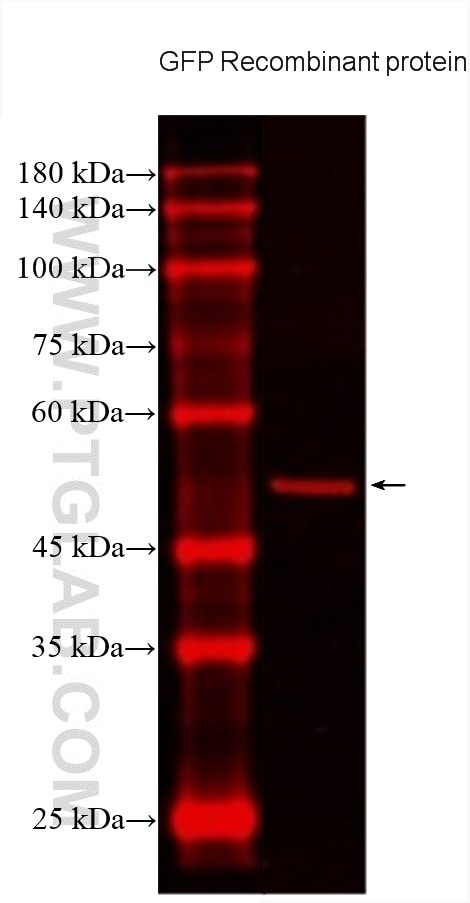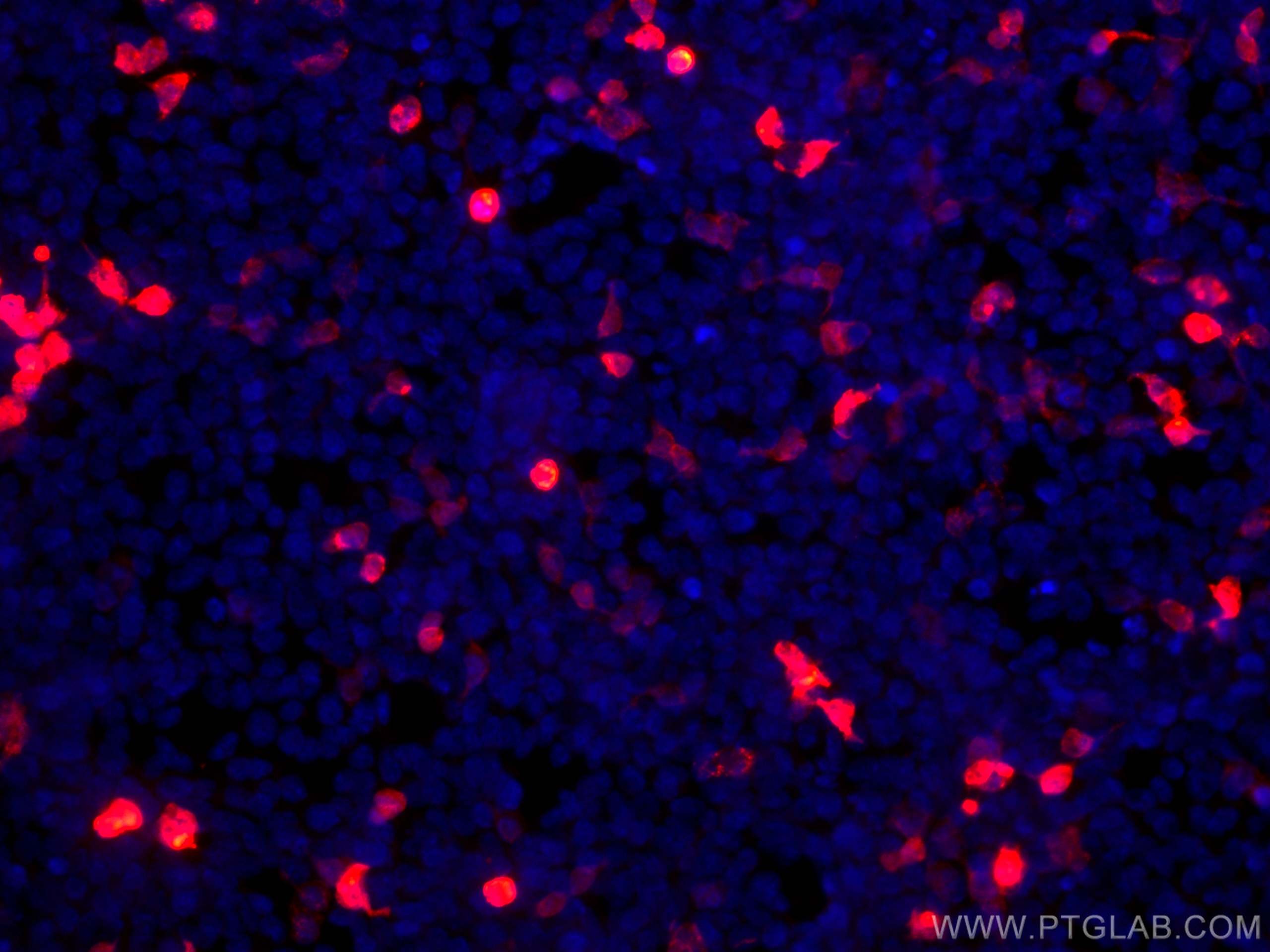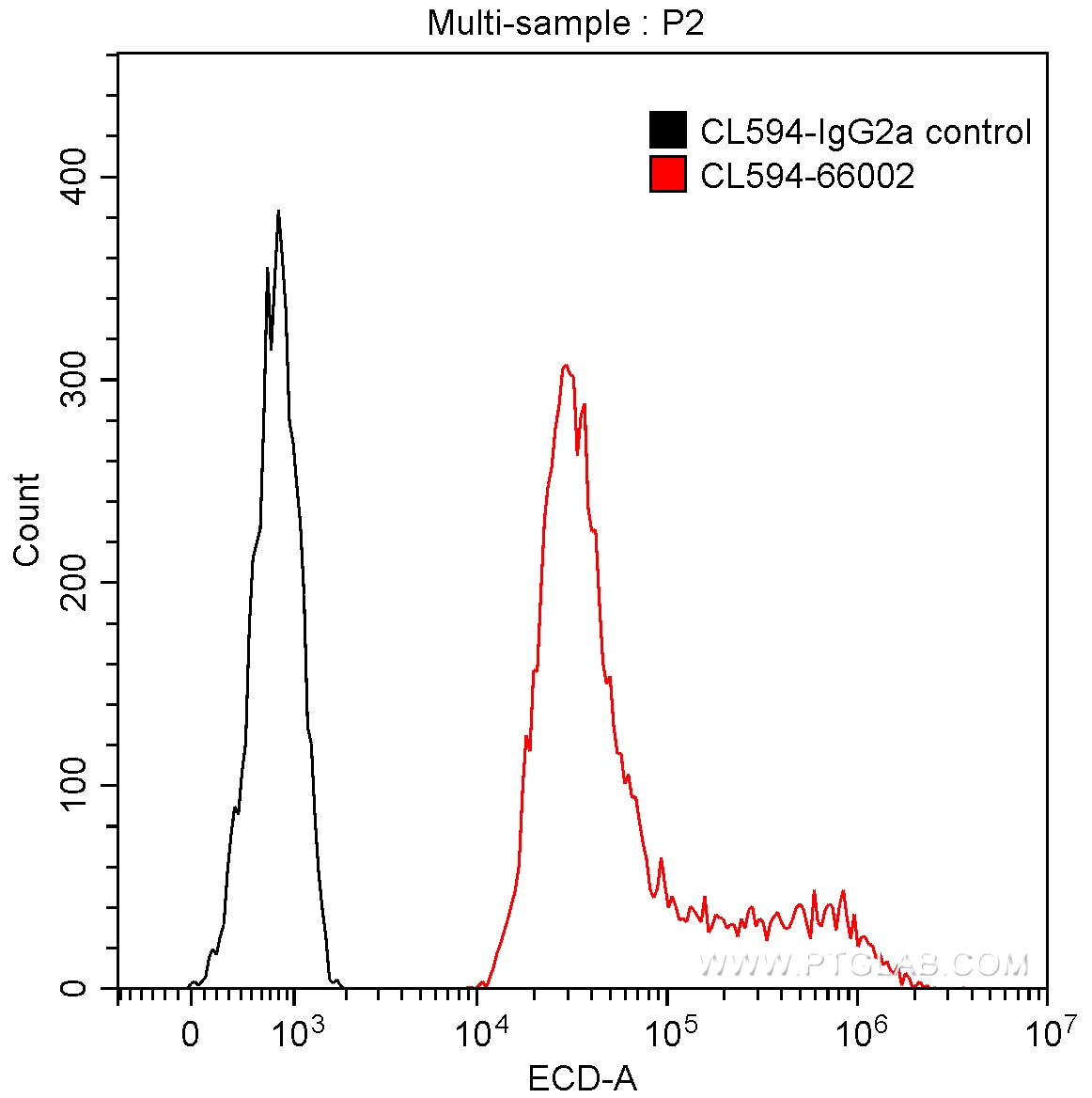GFP tag Monoklonaler Antikörper
GFP tag Monoklonal Antikörper für FC (Intra), IF, WB
Wirt / Isotyp
Maus / IgG2a
Getestete Reaktivität
rekombinanten Protein
Anwendung
WB, IF, FC (Intra)
Konjugation
CoraLite®594 Fluorescent Dye
CloneNo.
1E10H7
Kat-Nr. : CL594-66002
Synonyme
Galerie der Validierungsdaten
Geprüfte Anwendungen
| Erfolgreiche Detektion in WB | Recombinant protein |
| Erfolgreiche Detektion in IF | Transfizierte HEK-293-Zellen |
| Erfolgreiche Detektion in FC | Transfizierte HEK-293-Zellen |
Empfohlene Verdünnung
| Anwendung | Verdünnung |
|---|---|
| Western Blot (WB) | WB : 1:2000-1:10000 |
| Immunfluoreszenz (IF) | IF : 1:50-1:500 |
| Durchflusszytometrie (FC) | FC : 0.20 ug per 10^6 cells in a 100 µl suspension |
| It is recommended that this reagent should be titrated in each testing system to obtain optimal results. | |
| Sample-dependent, check data in validation data gallery | |
Produktinformation
CL594-66002 bindet in WB, IF, FC (Intra) GFP tag und zeigt Reaktivität mit rekombinanten Protein
| Getestete Reaktivität | rekombinanten Protein |
| Wirt / Isotyp | Maus / IgG2a |
| Klonalität | Monoklonal |
| Typ | Antikörper |
| Immunogen | GFP tag fusion protein Ag2128 |
| Vollständiger Name | GFP tag |
| Berechnetes Molekulargewicht | 26 kDa |
| GenBank-Zugangsnummer | U73901 |
| Gene symbol | |
| Gene ID (NCBI) | |
| Konjugation | CoraLite®594 Fluorescent Dye |
| Excitation/Emission maxima wavelengths | 588 nm / 604 nm |
| Form | Liquid |
| Reinigungsmethode | Protein-A-Reinigung |
| Lagerungspuffer | BS mit 50% Glyzerin, 0,05% Proclin300, 0,5% BSA, pH 7,3. |
| Lagerungsbedingungen | Bei -20°C lagern. Vor Licht schützen. Nach dem Versand ein Jahr stabil. Aliquotieren ist bei -20oC Lagerung nicht notwendig. 20ul Größen enthalten 0,1% BSA. |
Hintergrundinformationen
Green fluorescence protein (GFP) is a protein composed of 238 amino acid residues (26.9kDa) derived from the jellyfish Aequorea Victoria which emits green light (emission peak at 509nm) when excited by blue light (excitation peak at 395nm). GFP, when exposed to light in the blue to ultraviolet spectrum, will show a bright green fluorescent light, making it a very useful tool in research.
What is the molecular weight of GFP?
26.9 kDa
How does GFP work?
GFP was first isolated from the jellyfish Aequorea Victoria, a source of bioluminescence, in the 1960s and in 2008 the Nobel Prize in Chemistry was awarded "for the discovery and development of the green fluorescent protein, GFP" to Osamu Shimomura and colleagues, who recognized its potential in research (PMID: 13911999). A short amino acid sequence within the protein acts as the chromophore, which absorbs UV light at 395 nm and emits green light at 509 nm.
Why is GFP a useful reporter?
When GFP was sequenced in 1992 (PMID: 1347277) it allowed scientists to express it in other organisms using transgenic techniques. It does not require cofactors to work, is non-toxic to live cells, and is relatively small, making it ideal as a "tag" for other proteins, identifiable by shining a UV light and observing the green fluorescence. The tertiary folded structure of GFP forms a chromophore at the center of a barrel shape, which protects the fluorescence-emitting amino acid chain from solvents, meaning it can function in many environments (PMID 9759496).
What are the applications for GFP?
When expressed attached to another protein, GFP can be used as a reporter gene to measure expression levels or can easily be used in fluorescence microscopy. It has been used to highlight proteins in a variety of model organisms, including bacteria, zebrafish, and mice.
Protokolle
| Produktspezifische Protokolle | |
|---|---|
| WB protocol for CL594 GFP tag antibody CL594-66002 | Protokoll herunterladen |
| IF protocol for CL594 GFP tag antibody CL594-66002 | Protokoll herunterladen |
| FC protocol for CL594 GFP tag antibody CL594-66002 | Protokoll herunterladen |
| Standard-Protokolle | |
|---|---|
| Klicken Sie hier, um unsere Standardprotokolle anzuzeigen |




